动词《第三人称单数形式》的变化规则
- 格式:doc
- 大小:24.50 KB
- 文档页数:3
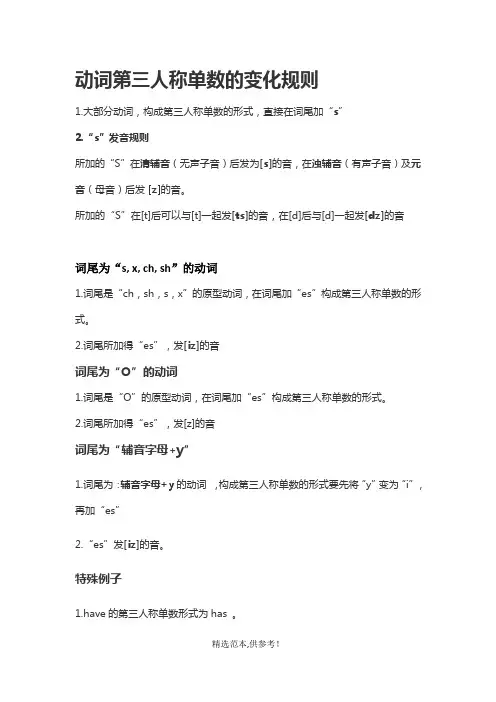
动词第三人称单数的变化规则
1.大部分动词,构成第三人称单数的形式,直接在词尾加“s”
2.“s”发音规则
所加的“S”在清辅音(无声子音)后发为[s]的音,在浊辅音(有声子音)及元音(母音)后发[z]的音。
所加的“S”在[t]后可以与[t]一起发[ts]的音,在[d]后与[d]一起发[dz]的音
词尾为“s, x, ch, sh”的动词
1.词尾是“ch,sh,s,x”的原型动词,在词尾加“es”构成第三人称单数的形式。
2.词尾所加得“es”,发[iz]的音
词尾为“O”的动词
1.词尾是“O”的原型动词,在词尾加“es”构成第三人称单数的形式。
2.词尾所加得“es”,发[z]的音
词尾为“辅音字母+y”
1.词尾为:辅音字母+y的动词,构成第三人称单数的形式要先将“y”变为“i”,再加“es”
2.“es”发[iz]的音。
特殊例子
1.have的第三人称单数形式为has 。
1
【本文档内容可以自由复制内容或自由编辑修改内容期待你的好评和关注,我们将会做得更好】。
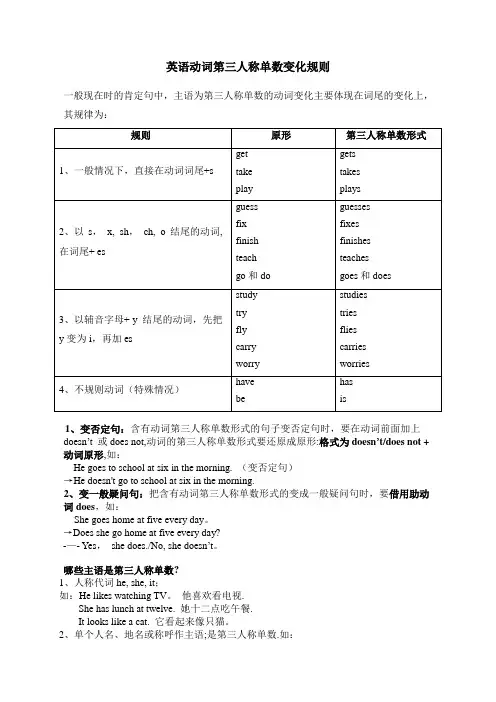
英语动词第三人称单数变化规则一般现在时的肯定句中,主语为第三人称单数的动词变化主要体现在词尾的变化上,其规律为:1、变否定句:含有动词第三人称单数形式的句子变否定句时,要在动词前面加上doesn’t 或does not,动词的第三人称单数形式要还原成原形:格式为doesn’t/does not + 动词原形,如:He goes to school at six in the morning. (变否定句)→He doesn't go to school at six in the morning.2、变一般疑问句:把含有动词第三人称单数形式的变成一般疑问句时,要借用助动词does,如:She goes home at five every day。
→Does she go home at five every day?-—- Yes,she does./No, she doesn’t。
哪些主语是第三人称单数?1、人称代词he, she, it;如:He likes watching TV。
他喜欢看电视.She has lunch at twelve. 她十二点吃午餐.It looks like a cat. 它看起来像只猫。
2、单个人名、地名或称呼作主语;是第三人称单数.如:Han Mei looks like her mother. 韩梅看起来像她的母亲.Beijing is in China. 北京在中国。
Uncle Wang often makes cakes. 王叔叔经常做蛋糕。
3、单数可数名词或this / that / the + 单数可数名词作主语时,是第三人称单数;A horse is a useful animal. 马是有用的动物.This book is yours. 这本书是你的.That car is red。
那辆小汽车是红色的。
The cat is Lucy's. 只猫是露茜的.4、不可数名词作主语时为第三人称单数.如:The milk is in the glass。
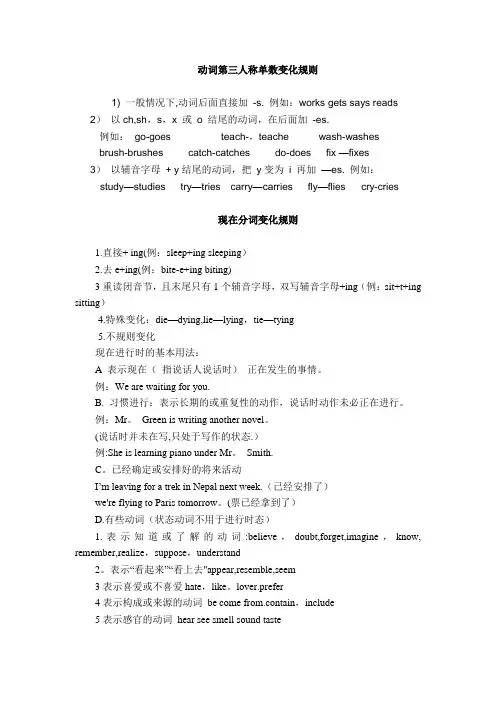
动词第三人称单数变化规则1) 一般情况下,动词后面直接加-s. 例如:works gets says reads2)以ch,sh,s,x 或o 结尾的动词,在后面加-es.例如: go-goes teach-,teache wash-washesbrush-brushes catch-catches do-does fix —fixes3)以辅音字母+ y结尾的动词,把y变为i 再加—es. 例如:study—studies try—tries carry—carries fly—flies cry-cries现在分词变化规则1.直接+ ing(例:sleep+ing sleeping)2.去e+ing(例:bite-e+ing biting)3重读闭音节,且末尾只有1个辅音字母,双写辅音字母+ing(例:sit+t+ing sitting)4.特殊变化:die—dying,lie—lying,tie—tying5.不规则变化现在进行时的基本用法:A 表示现在(指说话人说话时)正在发生的事情。
例:We are waiting for you.B. 习惯进行:表示长期的或重复性的动作,说话时动作未必正在进行。
例:Mr。
Green is writing another novel。
(说话时并未在写,只处于写作的状态.)例:She is learning piano under Mr。
Smith.C。
已经确定或安排好的将来活动I’m leaving for a trek in Nepal next week.(已经安排了)we're flying to Paris tomorrow。
(票已经拿到了)D.有些动词(状态动词不用于进行时态)1.表示知道或了解的动词:believe,doubt,forget,imagine,know, remember,realize,suppose,understand2。
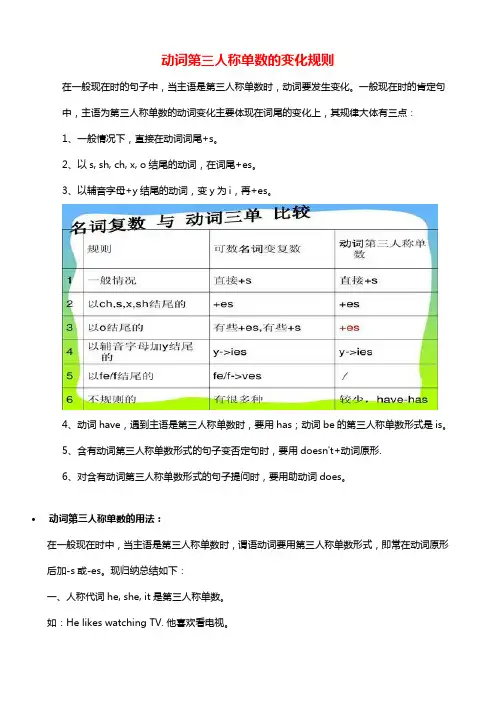
动词第三人称单数的变化规则在一般现在时的句子中,当主语是第三人称单数时,动词要发生变化。
一般现在时的肯定句中,主语为第三人称单数的动词变化主要体现在词尾的变化上,其规律大体有三点:1、一般情况下,直接在动词词尾+s。
2、以s, sh, ch, x, o结尾的动词,在词尾+es。
3、以辅音字母+y结尾的动词,变y为i,再+es。
4、动词have,遇到主语是第三人称单数时,要用has;动词be的第三人称单数形式是is。
5、含有动词第三人称单数形式的句子变否定句时,要用doesn't+动词原形.6、对含有动词第三人称单数形式的句子提问时,要用助动词does。
•动词第三人称单数的用法:在一般现在时中,当主语是第三人称单数时,谓语动词要用第三人称单数形式,即常在动词原形后加-s或-es。
现归纳总结如下:一、人称代词he, she, it是第三人称单数。
如:He likes watching TV. 他喜欢看电视。
She has lunch at twelve. 她十二点吃午餐。
It looks like a cat. 它看起来像只猫。
二、单个人名、地名或称呼作主语;是第三人称单数。
如:①HanMei looks like her mother. 韩梅看起来像她的母亲。
②Beijing is in China. 北京在中国。
③UncleWang often makes cakes. 王叔叔经常做蛋糕。
三、单数可数名词或"this/that/the+单数可数名词"作主语时,是第三人称单数。
如:①A horse is a useful animal.马是有用的动物。
②This book is yours.这本书是你的。
③That car is red.那辆小汽车是红色的。
④The cat is Lucy's.这只猫是露茜的。
四、不定代词someone, somebody, nobody, everything, something等及指示代词this, that 作主语时,是第三人称单数。
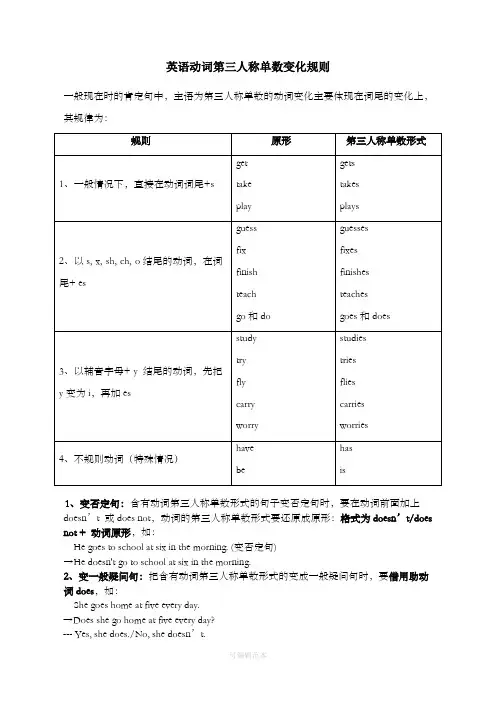
英语动词第三人称单数变化规则一般现在时的肯定句中,主语为第三人称单数的动词变化主要体现在词尾的变化上,其规律为:1、变否定句:含有动词第三人称单数形式的句子变否定句时,要在动词前面加上doesn’t 或does not,动词的第三人称单数形式要还原成原形:格式为doesn’t/does not + 动词原形,如:He goes to school at six in the morning. (变否定句)→He doesn't go to school at six in the morning.2、变一般疑问句:把含有动词第三人称单数形式的变成一般疑问句时,要借用助动词does,如:She goes home at five every day.→Does she go home at five every day?--- Yes, she does./No, she doesn’t.哪些主语是第三人称单数?1、人称代词he, she, it;如:He likes watching TV. 他喜欢看电视。
She has lunch at twelve. 她十二点吃午餐。
It looks like a cat. 它看起来像只猫。
2、单个人名、地名或称呼作主语;是第三人称单数。
如:Han Mei looks like her mother. 韩梅看起来像她的母亲。
Beijing is in China. 北京在中国。
Uncle Wang often makes cakes. 王叔叔经常做蛋糕。
3、单数可数名词或this / that / the + 单数可数名词作主语时,是第三人称单数;A horse is a useful animal. 马是有用的动物。
This book is yours. 这本书是你的。
That car is red. 那辆小汽车是红色的。
The cat is Lucy's. 只猫是露茜的。
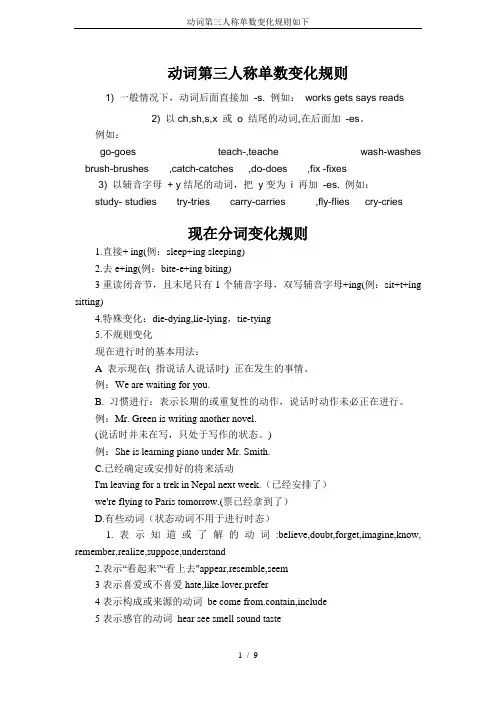
动词第三人称单数变化规则1) 一般情况下,动词后面直接加-s. 例如:works gets says reads2) 以ch,sh,s,x 或o 结尾的动词,在后面加-es。
例如:go-goes teach-,teache wash-washes brush-brushes ,catch-catches ,do-does ,fix -fixes3) 以辅音字母+ y结尾的动词,把y变为i 再加-es. 例如:study- studies try-tries carry-carries ,fly-flies cry-cries现在分词变化规则1.直接+ ing(例:sleep+ing sleeping)2.去e+ing(例:bite-e+ing biting)3重读闭音节,且末尾只有1个辅音字母,双写辅音字母+ing(例:sit+t+ing sitting)4.特殊变化:die-dying,lie-lying,tie-tying5.不规则变化现在进行时的基本用法:A 表示现在( 指说话人说话时) 正在发生的事情。
例:We are waiting for you.B. 习惯进行:表示长期的或重复性的动作,说话时动作未必正在进行。
例:Mr. Green is writing another novel.(说话时并未在写,只处于写作的状态。
)例:She is learning piano under Mr. Smith.C.已经确定或安排好的将来活动I'm leaving for a trek in Nepal next week.(已经安排了)we're flying to Paris tomorrow.(票已经拿到了)D.有些动词(状态动词不用于进行时态)1.表示知道或了解的动词:believe,doubt,forget,imagine,know, remember,realize,suppose,understand2.表示“看起来”“看上去"appear,resemble,seem3表示喜爱或不喜爱hate,like.lover.prefer4表示构成或来源的动词be come from.contain,include5表示感官的动词hear see smell sound taste6表示拥有的动词belong to.need.own .possess.want wish1、现在进行时的构成现在进行时由"be+v-ing"构成。
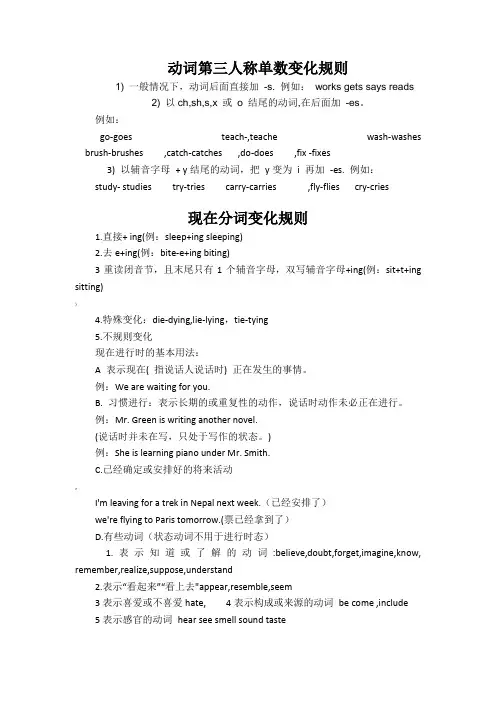
动词第三人称单数变化规则1) 一般情况下,动词后面直接加-s. 例如:works gets says reads2) 以ch,sh,s,x 或o 结尾的动词,在后面加-es。
例如:go-goes teach-,teache wash-washes brush-brushes ,catch-catches ,do-does ,fix -fixes3) 以辅音字母+ y结尾的动词,把y变为i 再加-es. 例如:study- studies try-tries carry-carries ,fly-flies cry-cries现在分词变化规则1.直接+ ing(例:sleep+ing sleeping)2.去e+ing(例:bite-e+ing biting)3重读闭音节,且末尾只有1个辅音字母,双写辅音字母+ing(例:sit+t+ing sitting)》4.特殊变化:die-dying,lie-lying,tie-tying5.不规则变化现在进行时的基本用法:A 表示现在( 指说话人说话时) 正在发生的事情。
例:We are waiting for you.B. 习惯进行:表示长期的或重复性的动作,说话时动作未必正在进行。
例:Mr. Green is writing another novel.(说话时并未在写,只处于写作的状态。
)例:She is learning piano under Mr. Smith.C.已经确定或安排好的将来活动>I'm leaving for a trek in Nepal next week.(已经安排了)we're flying to Paris tomorrow.(票已经拿到了)D.有些动词(状态动词不用于进行时态)1.表示知道或了解的动词:believe,doubt,forget,imagine,know, remember,realize,suppose,understand2.表示“看起来”“看上去"appear,resemble,seem3表示喜爱或不喜爱hate,4表示构成或来源的动词be come ,include5表示感官的动词hear see smell sound taste6表示拥有的动词belong . wish1、现在进行时的构成现在进行时由"be+v-ing"构成。
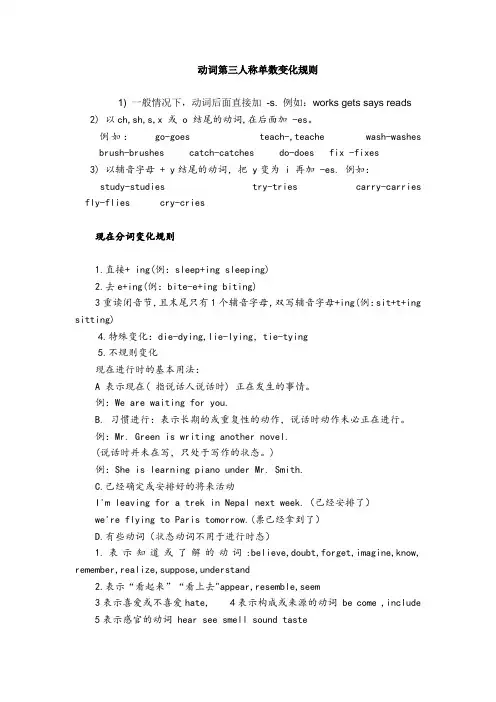
动词第三人称单数变化规则1) 一般情况下,动词后面直接加-s. 例如:works gets says reads2) 以ch,sh,s,x 或 o 结尾的动词,在后面加 -es。
例如:go-goes teach-,teache wash-washes brush-brushes catch-catches do-does fix -fixes3) 以辅音字母 + y结尾的动词,把 y变为 i 再加 -es. 例如:study-studies try-tries carry-carries fly-flies cry-cries现在分词变化规则1.直接+ ing(例:sleep+ing sleeping)2.去e+ing(例:bite-e+ing biting)3重读闭音节,且末尾只有1个辅音字母,双写辅音字母+ing(例:sit+t+ing sitting)4.特殊变化:die-dying,lie-lying,tie-tying5.不规则变化现在进行时的基本用法:A 表示现在( 指说话人说话时) 正在发生的事情。
例:We are waiting for you.B. 习惯进行:表示长期的或重复性的动作,说话时动作未必正在进行。
例:Mr. Green is writing another novel.(说话时并未在写,只处于写作的状态。
)例:She is learning piano under Mr. Smith.C.已经确定或安排好的将来活动I'm leaving for a trek in Nepal next week.(已经安排了)we're flying to Paris tomorrow.(票已经拿到了)D.有些动词(状态动词不用于进行时态)1.表示知道或了解的动词:believe,doubt,forget,imagine,know, remember,realize,suppose,understand2.表示“看起来”“看上去"appear,resemble,seem3表示喜爱或不喜爱hate, 4表示构成或来源的动词 be come ,include 5表示感官的动词 hear see smell sound taste6表示拥有的动词belong . wish1、现在进行时的构成现在进行时由"be+v-ing"构成。
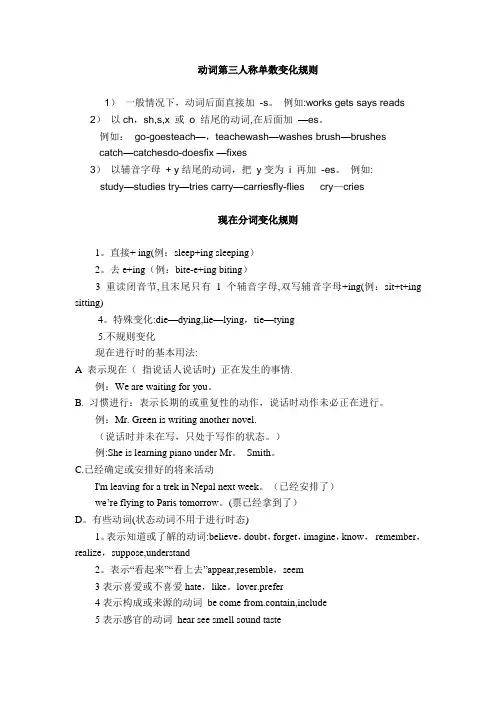
动词第三人称单数变化规则1)一般情况下,动词后面直接加-s。
例如:works gets says reads 2)以ch,sh,s,x 或o 结尾的动词,在后面加—es。
例如: go-goesteach—,teachewash—washes brush—brushescatch—catchesdo-doesfix —fixes3)以辅音字母+ y结尾的动词,把y变为i 再加-es。
例如:study—studies try—tries carry—carriesfly-flies cry—cries现在分词变化规则1。
直接+ ing(例:sleep+ing sleeping)2。
去e+ing(例:bite-e+ing biting)3重读闭音节,且末尾只有1个辅音字母,双写辅音字母+ing(例:sit+t+ing sitting)4。
特殊变化:die—dying,lie—lying,tie—tying5.不规则变化现在进行时的基本用法:A 表示现在(指说话人说话时) 正在发生的事情.例:We are waiting for you。
B. 习惯进行:表示长期的或重复性的动作,说话时动作未必正在进行。
例:Mr. Green is writing another novel.(说话时并未在写,只处于写作的状态。
)例:She is learning piano under Mr。
Smith。
C.已经确定或安排好的将来活动I'm leaving for a trek in Nepal next week。
(已经安排了)we’re flying to Paris tomorrow。
(票已经拿到了)D。
有些动词(状态动词不用于进行时态)1。
表示知道或了解的动词:believe,doubt,forget,imagine,know,remember,realize,suppose,understand2。
表示“看起来”“看上去”appear,resemble,seem3表示喜爱或不喜爱hate,like。
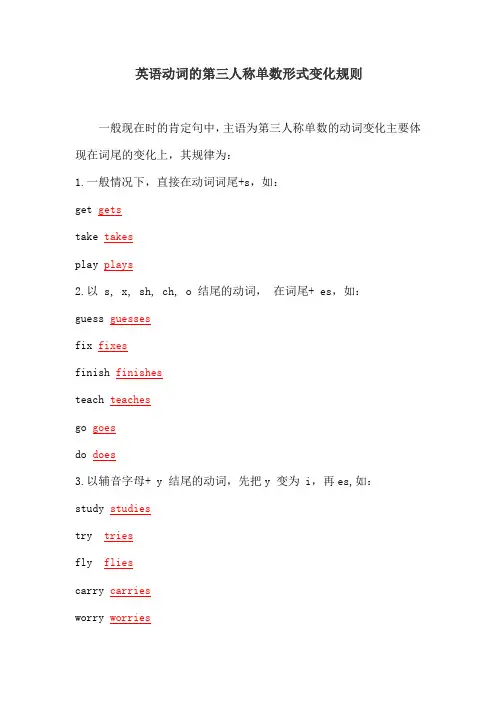
英语动词的第三人称单数形式变化规则一般现在时的肯定句中,主语为第三人称单数的动词变化主要体现在词尾的变化上,其规律为:1.一般情况下,直接在动词词尾+s,如:get getstake takesplay plays2.以 s, x, sh, ch, o 结尾的动词,在词尾+ es,如:guess guessesfix fixesfinish finishesteach teachesgo goesdo does3.以辅音字母+ y 结尾的动词,先把y 变为 i,再es,如:study studiestry triesfly fliescarry carriesworry worries4.不规则动词(特殊情况)have hasbe is一般现在时的否定句中:含有动词第三人称单数形式的句子变否定句时,要在动词前面加上doesn`t 或 does not,动词的第三人称单数形式要还原成原形:格式为 doesn`t/does not+ 动词原形,如:He goes to school at six in the morning. (变否定句)→He doesn`t go to school at six in the morning.一般现在时的疑问句中:把含有动词第三人称单数形式的变成一般疑问句时,要借用助动词 does,如:She goes home at five every day.→Does she go home at five every day?---- Yes, she does./No, she doesn`t.一般现在时对划线部分进行提问中:对划线部分进行提问(变特殊疑问句):一般格式为 Wh(疑问词) + 一般疑问句?She goes home at five every day. (对划线部分提问)→When does she go home every day?She goes home at five every day. (对划线部分提问)→Who goes home at five every day?She goes home at five every day. (对划线部分提问)→What does she do at five every day?。
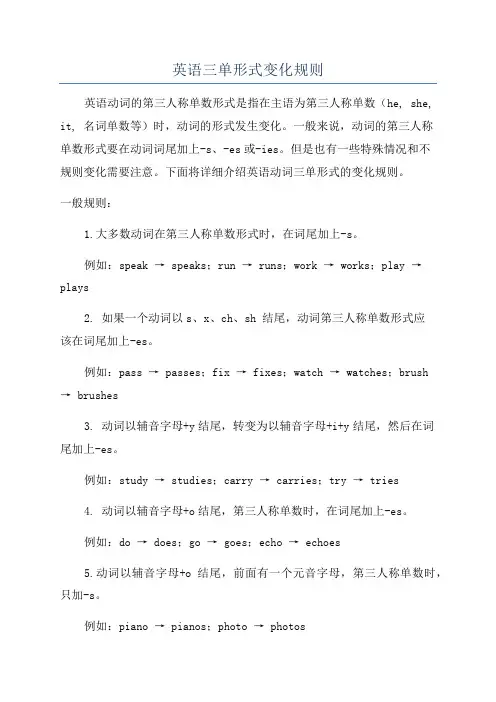
英语三单形式变化规则英语动词的第三人称单数形式是指在主语为第三人称单数(he, she, it, 名词单数等)时,动词的形式发生变化。
一般来说,动词的第三人称单数形式要在动词词尾加上-s、-es或-ies。
但是也有一些特殊情况和不规则变化需要注意。
下面将详细介绍英语动词三单形式的变化规则。
一般规则:1.大多数动词在第三人称单数形式时,在词尾加上-s。
例如:speak → speaks;run → runs;work → works;play → plays2. 如果一个动词以s、x、ch、sh 结尾,动词第三人称单数形式应该在词尾加上-es。
例如:pass → passes;fix → fixes;watch → watches;brush→ brushes3. 动词以辅音字母+y结尾,转变为以辅音字母+i+y结尾,然后在词尾加上-es。
例如:study → studies;carry → carries;try → tries4. 动词以辅音字母+o结尾,第三人称单数时,在词尾加上-es。
例如:do → does;go → goes;echo → echoes5.动词以辅音字母+o结尾,前面有一个元音字母,第三人称单数时,只加-s。
例如:piano → pianos;photo → photos6. 动词以辅音字母+consonant字母+ y 结尾,将y改为ies。
例如:study → studies;fly → flies;cry → cries7.动词以“辅音字母+_y”的形式结尾,但是该辅音字母前是一个元音字母。
这种情况下,动词的第三人称单数形式在词尾加上-s。
例如:play → plays;pray → prays;enjoy → enjoys不规则变化:除了一般的规则以外,还有一些常见的动词变化形式是不规则的,需要单独记忆。
1. be → is(am,are)例如:She is a student. → He is a teacher.注意:be动词变化形式较为特殊,主语为第三人称单数时,is是be 动词的正确形式。
动词的三单形式变化规则
1.一般情况下,动词直接加上-s。
例如:speak(讲话)→ he speaks(他讲话);run(跑步)→ she runs(她跑步)
2. 动词如果以-s、-ch、-sh、-x、-o结尾,要加上-es。
例如:pass(通过)→ it passes(它通过);watch(观看)→ she watches(她观看)
3. 动词如果以辅音字母+y结尾,要将y变为i,再加上-es。
例如:study(学习)→ he studies(他学习);try(尝试)→ she tries(她尝试)
4. 以“be”开头的动词“have”和“go”在第三人称单数形式中变化为“is”和“goes”。
例如:he has(他有)→ she has(她有);he goes(他去)→ she goes(她去)
需要注意的是,以上规则虽然适用于大多数情况,但仍有一些例外,例如一些不规则动词(如have、do等)就不按照上述规则变化。
因此,在学习时还需要额外注意这些特殊动词的变化形式。
单词第三人称单数形式变化规则
英语中,动词的第三人称单数形式与其他形式有所不同。
以下是第三人称单数形式变化的规则:
1. 如果动词以辅音字母加y结尾,将y变为i,再加上-es。
例如:study(学习)的第三人称单数形式为studies(学习)。
2. 如果动词以“s, x, ch, sh”结尾,加上-es。
例如:pass (通过)的第三人称单数形式为passes(通过)。
3. 如果动词以元音字母加y结尾,直接加上-s。
例如:play(玩)的第三人称单数形式为plays(玩)。
4. 如果动词以辅音字母加o结尾,加上-es。
例如:go(去)的第三人称单数形式为goes(去)。
5. 对于大多数动词,直接加上-s。
例如:walk(走)的第三人
称单数形式为walks(走)。
需要注意的是,有些动词的第三人称单数形式会有不规则变化,例如:be(是)的第三人称单数形式为is(是),have(有)的第三人称单数形式为has(有)。
掌握这些规则和不规则变化,可以帮助我们更好地理解英语语法,提高英语写作和口语表达的能力。
- 1 -。
动词单三变化规则
一般情况下,英语动词变为单数第三人称形式的规则如下:
1. 对于大多数动词,只需在动词词尾加上字母"s"。
例如:play → plays, speak → speaks。
2. 若动词以字母s, x, z, ch, sh结尾,则需在词尾加上字母"es"。
例如:pass → passes, watch → watches。
3. 若动词以“辅音字母+y”结尾,则将"y"改为"i",再加上"es"。
例如:study → studies, fly → flies。
4. 若动词以“o”结尾,则需在词尾加上字母"es"。
但存在一些特例,如do → does, go → goes。
5. 一些不规则动词的单数第三人称形式需要特别记忆,例如:have
→ has, do → does, be → is/are。
需要注意的是,以上规则并不适用于所有动词,有些动词在单数第三
人称形式时会发生其他变化,所以在学习时还需要特别注意不规则动词的
变化形式。
动词第三人称单数变化规则1)一般情况下,动词后面直接加—s。
例如:works gets says reads2) 以ch,sh,s,x 或o 结尾的动词,在后面加-es。
例如: go—goesteach—,teachewash-washes brush-brushescatch-catchesdo-doesfix -fixes3)以辅音字母+ y结尾的动词,把y变为i 再加—es。
例如:study—studies try—tries carry—carriesfly—flies cry-cries现在分词变化规则1.直接+ ing(例:sleep+ing sleeping)2.去e+ing(例:bite-e+ing biting)3重读闭音节,且末尾只有1个辅音字母,双写辅音字母+ing(例:sit+t+ing sitting)4。
特殊变化:die—dying,lie—lying,tie-tying5。
不规则变化现在进行时的基本用法:A 表示现在( 指说话人说话时) 正在发生的事情。
例:We are waiting for you.B。
习惯进行:表示长期的或重复性的动作,说话时动作未必正在进行。
例:Mr。
Green is writing another novel.(说话时并未在写,只处于写作的状态.)例:She is learning piano under Mr. Smith。
C。
已经确定或安排好的将来活动I’m leaving for a trek in Nepal next week。
(已经安排了)we’re flying to Paris tomorrow.(票已经拿到了)D.有些动词(状态动词不用于进行时态)1。
表示知道或了解的动词:believe,doubt,forget,imagine,know,remember,realize,suppose,understand2.表示“看起来"“看上去”appear,resemble,seem3表示喜爱或不喜爱hate,like.lover。
动词第三人称单数变化规则1) 一般情况下,动词后面直接加—s. 例如:works gets says reads2)以ch,sh,s,x 或o 结尾的动词,在后面加-es。
例如: go-goesteach—,teachewash-washes brush-brushescatch—catchesdo-doesfix -fixes3) 以辅音字母+ y结尾的动词,把y变为i 再加—es. 例如:study-studies try—tries carry—carriesfly-flies cry-cries现在分词变化规则1。
直接+ ing(例:sleep+ing sleeping)2.去e+ing(例:bite-e+ing biting)3重读闭音节,且末尾只有1个辅音字母,双写辅音字母+ing(例:sit+t+ing sitting)4.特殊变化:die-dying,lie-lying,tie-tying5。
不规则变化现在进行时的基本用法:A 表示现在(指说话人说话时)正在发生的事情。
例:We are waiting for you.B. 习惯进行:表示长期的或重复性的动作,说话时动作未必正在进行。
例:Mr。
Green is writing another novel.(说话时并未在写,只处于写作的状态.)例:She is learning piano under Mr. Smith.C。
已经确定或安排好的将来活动I'm leaving for a trek in Nepal next week。
(已经安排了)we’re flying to Paris tomorrow。
(票已经拿到了)D。
有些动词(状态动词不用于进行时态)1.表示知道或了解的动词:believe,doubt,forget,imagine,know,remember,realize,suppose,understand2。
小学英语动词第三人称单数变化规则一般现在时的肯定句中,主语为第三人称单数的动词变化主要体现在词尾的变化上,其规律为:1、变否定句:格式为doesn’t/does not + 动词原形,如:He goes to school at six in the morning. (变否定句)→He doesn't go to school at six in the morning.2、变一般疑问句:要借用助动词does,如:She goes home at five every day.→Does she go home at five every day?--- Yes, she does./No, she doesn’t.哪些主语是第三人称单数?除I、you之外的所有可数名词单数及不可数名词。
(he she it 个人名)例题引路:判断下列词语哪些是第三人称单数,是请打“√”不是请打“×”。
he ( ) we( ) she( ) they( )it ( ) Han Mei ( ) uncle Wang ( )the farmers( ) my mother( ) Linda( )Sally and Lucy( ) the dog( ) the cats( )1、写出下列动词的第三人称单数。
drink ________ go _______ stay ________ make ________ look _________ have_______ pass_______ carry _______ come________ watch________ plant_______ fly ________ study_______ brush________ teach________ 2、用括号内动词的适当形式填空。
1. He often ________(have) dinner at home.2. We _____________ (not watch) TV on Monday.3. Nick ___________ (not go) to the zoo on Sunday.4. ________ they __________ (like) the World Cup?5. What _________they often _________ (do) on Saturdays?6. _________ your parents _________ (read) newspapers every day?7. There ________(be) some water in the bottle.8. My aunt _______(look) after her baby carefully.9. The child often _______(watch) TV in the evening.10. Mike’s sister ________ (cook) nice food. I _______ (like) eating it very much. 21. _______ (do) your brother_______ (watch) TV in the evening? No, he_______ (not).3、选出正确的答案:1. She (like / likes) to play football.2. He (like / likes) drinking milk.3. I (like / likes) to watch TV.4. We (like / likes) to play badminton.5. They (like / likes) to sing songs.6. She (read / reads) books every day.7. He (play / plays) computer games every day.8. It (listen / listens) to the radio every day.9. Linda (draw / draws) pictures every day.10. Jane and Linda (play / plays) football every day.5、把下列句子变为否定句:1. We like playing football.2. Linda swims every day.3. They like playing games.4. My father reads newspaper in the evening.7、把下列句子变为疑问句,并做肯定和否定回答。
小学英语动词第三人称单数变化规则
一般现在时的肯定句中,主语为第三人称单数的动词变化主要体现在词尾的变化上,其规律为:
}
1、变否定句:格式为doesn’t/does not + 动词原形,如:
He goes to school at six in the morning. (变否定句)
→He doesn't go to school at six in the morning.
2、变一般疑问句:要借用助动词does,如:
She goes home at five every day.
→Does she go home at five every day
--- Yes, she does./No, she doesn’t.
哪些主语是第三人称单数
'
除I、you之外的所有可数名词单数及不可数名词。
(he she it 个人名)
例题引路:
判断下列词语哪些是第三人称单数,是请打“√”不是请打“×”。
he ( ) we( ) she( ) they( )
it ( ) Han Mei ( ) uncle Wang ( )
~
the farmers( ) my mother( ) Linda( )
Sally and Lucy( ) the dog( ) the cats( )
1、写出下列动词的第三人称单数。
drink ________ go _______ stay ________ make ________ look _________ have_______ pass_______ carry _______ come________ watch________ plant_______ fly ________ study_______ brush________ teach________
2、用括号内动词的适当形式填空。
1. He often ________(have) dinner at home.
(
2. We _____________ (not watch) TV on Monday.
3. Nick ___________ (not go) to the zoo on Sunday.
4. ________ they __________ (like) the World Cup
5. What _________they often _________ (do) on Saturdays
6. _________ your parents _________ (read) newspapers every day
7. There ________(be) some water in the bottle.
8. My aunt _______(look) after her baby carefully.
9. The child often _______(watch) TV in the evening.
10. Mike’s sister ________ (cook) nice food. I _______ (like) eating it very much.
21. _______ (do) your brother_______ (watch) TV in the evening No, he_______ (not).
)
3、选出正确的答案:
1. She (like / likes) to play football.
2. He (like / likes) drinking milk.
3. I (like / likes) to watch TV.
4. We (like / likes) to play badminton.
5. They (like / likes) to sing songs.
6. She (read / reads) books every day.
7. He (play / plays) computer games every day.
8. It (listen / listens) to the radio every day.
[
9. Linda (draw / draws) pictures every day.
10. Jane and Linda (play / plays) football every day.
5、把下列句子变为否定句:
1. We like playing football.
2. Linda swims every day.
3. They like playing games.
、
4. My father reads newspaper in the evening.
7、把下列句子变为疑问句,并做肯定和否定回答。
1. My brother can ride a horse.
4. We clean the classroom after school.
___________________________________________________________。